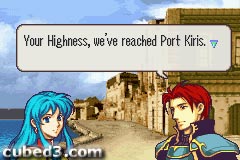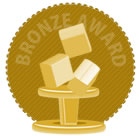Fire Emblem: The Sacred Stones (Game Boy Advance) Review
By Matthew Evans  05.09.2005
05.09.2005

In gaming there is two easily definable groups when it comes to sequels, on the one hand we have the "If it isn't broke why fix it?" segment, these are the people who will happily buy EA title 20XX, Final Fantasy MCMXVII or even Super Mario something or other (someone really should buy Princess Peach a can of pepper spray or send her on self-defence classes) purely on the basis that they enjoyed the first one. On the other hand we have sequephobes, those who complain that endless sequels destroy innovation and creativity in gaming, neglecting the fact that Super Mario 64 and Metroid Prime were both sequels in long running franchises. On that note we move onto the review of Fire Emblem: The Sacred Stones, the EIGHTH release in this long running series. Of course it's the Americans' second release and judging from sales of the previous title this might as well be Europe's second as well.
For those of you that have watched or read Japanese entertainment you might notice that their idea of a sequel or series is quite different to that of our western tastes. Where as we like to keep our series continuous or chapeterised like Star Wars, Lord of the Rings or Buffy the Vampire Slayer, the Japanese will have a plot line and character base run for one or two series with some spin-offs before completely changing everything but still labelling it as the same series. Look at the Final Fantasy franchise; apart from FFX-2 (which technically is not part of the sequence) not a single game from Final Fantasy to Final Fantasy XI has shared the same plot line or main cast yet it is still classed as a series.

Now before I completely lose you I best explain the point, Fire Emblem: The Sacred Stones is a Fire Emblem game. This game is almost identical to its predecessor in terms of game play, troops, weapons, spells, enemies, and so on. Apart from some tweaks this is almost the same game you bought (or at least should have bought) last time. The question is have these tweaks been for the better or for the worse.
For those of you who never played any of the series, this is a turn-based strategy game similar to Advance Wars or Lord of the Rings: The Third Age. You take it in turns to move all your units, take part in combat and try to achieve mission objectives. It sounds simple enough yet just like chess, playing it seems easy, but mastering it is another matter completely. Each unit has different strengths and weaknesses, terrain affects units differently and, in a paper-rock-scissors style, weapons and magic work stronger against one while weaker to the other. It is a case of trial and error while you work everything out, which is made even harder when dealing with the most contentious aspect of the game - permanent death. Unlike Advance Wars or LOTR, this is a campaign game, you cannot build new units and you do not get new ones at the beginning of each map. The units you have and collect are the units you keep; so when a unit dies that is it, it is dead and unusable for the rest of the campaign. The game also auto saves after the combat has been worked out, but before the animation starts so the only way to get that unit back is to replay the map from scratch. This can lead to a lot of frustration as you might play a map for over twenty turns and just as you are about to finish that archer you forgot about goes through your lines and takes out your Pegasus unit (archers get such a huge bonus against flying units its practically an instant kill) but it adds an extra challenge and helps build a bond between you and your troops.

As I mentioned, earlier this not a sequel like we are used to, heck it less than an updated version then we are used to. This is firmly a tweaked version and not all the tweaks have been for the better. One of the most noticeable differences is that you are no longer part of the action. In the previous title you were a non-playable unit classed as a strategist, it is no different to how it works now. However, the fact that the main characters are no longer introducing you to other characters that are asking for your assistance removes you from the game, making you feel more like a spectator than a part of the action. Even positive additions come with their own negatives; new units and upgrade options have been added but due to them being unbalanced, instead of broadening your options they have made previous units obsolete. So old favourites such as Paladins, Myrmidons and Assassins are no longer viable options as the newer ones are stronger, tougher and more versatile. So rather than having a wide range of units, you automatically disregard half of them as they are far too weak in comparison to other units.
The biggest addition to the game though has to be the world map, or at least it should have been. Even with the option to move around the world map the game is still linear; complete a chapter and a new chapter is opened, rinse and repeat. All the world map allows you to do is revisit shops or take part in skirmishes. There is the chance to go to previous maps that are inhabited with new enemies and the sole mission objective is to kill them all or to take part in the two side-quests. A succession of mini-map grinds where you cannot save in-between maps, a type of endurance test of both skill and patience (there is only a finite amount of time that you can kill the same enemies over and over again before it gets boring, after all). This is where the game ultimately falls down. No matter what the mission is, all it boils down to is the same thing; kill everything on the map that is red, and whilst you are experiencing new units it still seems fresh, yet shortly after it gets extremely boring. You resort to the same units, using the same tactics to kill the same units over and over again, the only variation is when you need to save a village, rescue a non-hostile unit or talk to someone in the hope that they will join you. These are rare instances and hardly break the monotony of the game. The characters and storyline are also somewhat lacking; it is all very generic and at times quite soppy which brings me onto another annoyance with the game - the low limit on support conversations. As units fight alongside each other they may develop emotional bonds of friendship and in some cases love. With each support conversation a little bit of story is revealed and a stats bonus is applied when the units are within range of each other. But the game limits you to five support conversation slots per unit, which is understandable with regards to the stat bonus, but when each story is three conversations you are limited to one full story per pair of units (a support conversation fills up a slot on both units) but when each unit can have five or more stories (fifteen or more conversations) to get the full amount you'd have to play through the game more times than its necessary.

Presentation-wise this game has not changed; being identical to the previous game in both sound and graphics and in all honestly neither game is up for any awards on this front. The nicest way to describe them is functional; the truest way to describe them would be bland and simplistic. I know it's a Gameboy Advance title and it's only a strategy title but that's no excuse when you consider the likes of the Golden Sun series of games, their age and how graphically superior they are for a similarly styled game.
Fire Emblem: The Sacred Stones is a game firmly for the strategists out there but even then there will be those who find it hard to dedicate too much time to this title. While it hasn't changed much from its previous incarnation it has shown us a glimpse of what the series could, and should be like but has failed to do. The basics are there and it is a good game but a lot of polish is required and unlike our eastern brethren who might lap up endless clones of the same formula we expect improvements with each successive title.

Cubed3 Rating
Very Good - Bronze Award

This is a good strategy game and while it has some improvements over the previous Fire Emblem it just doesn't hit the spot. If you have already completed the other Fire Emblem and both Advance Wars then this might be worth a look if you find it cheap on import but come its official release in Europe later this year you might be better off looking towards Advance Wars: Dual Strike or Fire Emblem: Path to Radiance.
Comments
Comments are currently disabled

 Sign In
Sign In Game Details
Game Details
 Out now
Out now  Out now
Out now  Out now
Out now  Out now
Out now  Subscribe to this topic
Subscribe to this topic Features
Features





 Top
Top

